| January 2020: MLK Day of Service, Updated CERT Curriculum, Youth Preparedness Council Application, and More |
| 01/09/2020 |
|
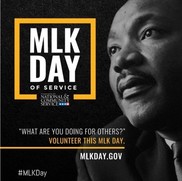
The 2020 Martin Luther King, Jr. (MLK) Day of Service is Monday, January 20. Treat the holiday as “a day on, not a day off,” and consider volunteering for a preparedness activity!
By volunteering this day and throughout the year, you can to engage with your community while honoring the legacy of Dr. King. For example, you can plan to mentor a young person on youth preparedness, help to clean up a public space, or work with your community to prepare for an emergency.
If you are still looking for a way to participate, consider these and other activities that build disaster preparedness:
Learn about other volunteer activities or search for opportunities in your area! Then, share your thoughts and photos from your volunteer service on social media with the hashtag #MLKDay.
Find more tools, tips, and resources to volunteer and strengthen your community with the Corporation for National and Community Service!
|
|
|
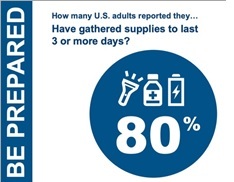
The Federal Emergency Management Agency (FEMA) has released results from the 2019 National Household Survey (NHS). The results from the 2019 NHS indicate an increase in the percentage of people who have taken preparedness actions and have savings set aside for an emergency. Read more…
|
Webinars: 2019 National Household Survey Findings
Join FEMA for a two-part webinar series to learn about the findings from the 2019 National Household Survey (NHS).
Part I: Preparedness & Individuals
Wednesday, January 22 at 3 p.m. ET
Register Here
|
Part II: Preparedness & Hazards
Wednesday, January 29 at 3 p.m. ET
Register Here
|

FEMA Releases 2018 National Household Survey Data on OpenFEMA for Use by Community Partners
In January 2020, the Federal Emergency Management Agency (FEMA) released the full results from the 2018 National Household Survey (NHS) on OpenFEMA.
With the release of the raw data, our partners, from academics and researchers to local emergency managers, can dig deeper into NHS findings. With the data on OpenFEMA, you can ask your own questions and analyze the data that is most important to your work and the communities you serve. Read more…
|
|
|
Do You Know Your Winter Weather Risk?
Nearly 70 percent of people in the U.S. live in areas with hazardous winter weather. However, only 13 percent of responses to the FEMA National Household Survey indicate that they are aware of winter weather as a risk. While more than 90 percent of respondents acknowledge that they are at risk for at least one disaster type, responses also showed that many people may not have correct information or awareness about their true winter weather risk.
Winter safety includes preparing now! Visit Ready.gov/winter-weather for more information on how you can prepare yourself and your community. Then, learn more from the 2018 NHS here.
|
ICYMI: 2018 National Household Survey Findings Webinars
In December 2019, FEMA hosted a two-part webinar series to learn about the findings from the 2018 National Household Survey (NHS). If you missed the webinars, you can listen to the recordings, find the presentations, and read the transcripts:
|
|
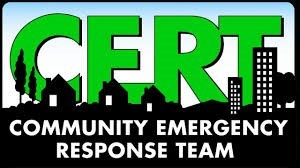
FEMA released the updated Community Emergency Response Team (CERT) Basic training curriculum on January 8.
The CERT Basic training curriculum covers topics in disaster preparedness, fire, medical operations, search and rescue, and team building. This course has been updated to include guidance for emerging types of emergency response, individual and community hazards, and to incorporate feedback from registered CERTs. Read more…
|
|
|
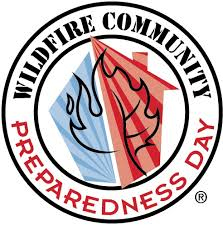
Wildfire Community Preparedness Day
Wildfire Community Preparedness Day is May 2, 2020. This year, the National Fire Protection Association (NFPA), in partnership with State Farm, will fund 150 awards for wildfire safety or rebuilding after a wildfire. Individuals and communities can apply for the $500 awards until February 28, 2020. The awards must be used for projects in the U.S. and U.S. territories.
By participating in Wildfire Community Preparedness Day, you and your community can help raise local awareness of wildfire risks. Your work and service can help create safer communities!
Learn more at nfpa.org.
Webinar
FEMA 101: Overview of the DHS Center for Faith and Opportunity Initiatives and FEMA Components
Everyday around the world, faith-based organizations serve the needs of people. Join this webinar on Thursday, January 30 at 2:00 p.m. ET to learn how the DHS Center for Faith and Opportunities Initiatives (DHS Center) is working with houses of worship and nonprofits connecting with FEMA and other federal partners. Register and learn more here.
|
2020 Preparedness Calendar Released
In December, FEMA’s Ready Campaign released the 2020 Preparedness Calendar. The Ready 2020 Preparedness Calendar is a planning tool that provides resources to help raise awareness and help engage communities on emergency and disaster preparedness.
The calendar reaffirms FEMA’s enduring commitment to build a culture of preparedness and a disaster-resilient nation. Informed, alert communities play a critical role in keeping our nation safe. Our partners are critical in increasing awareness by distributing materials and spreading the word about emergency preparedness. Download and share in English at www.ready.gov/calendar and in Spanish at www.listo.gov/es/calendario.
Webinar
Human Trafficking: The Hidden Crime
Join FEMA on Tuesday, January 21 at Noon ET, for a webinar discussing Human Trafficking: The Hidden Crime. Human trafficking is a hidden crime, and it can happen in any community. Victims can be any age, race, gender, or nationality. The first step to combating it is to identify victims so they can be rescued and help bring their perpetrators to justice. Education and awareness are the paths to a safer community. Register and learn more here.
|
|

Do you know a teen who has a passion for preparedness? Starting in January, FEMA will accept applications for its 2020 Youth Preparedness Council (YPC) from youth in grades 8-11. Since 2012, FEMA has brought youth from across the Nation together who have a mindset for preparedness and community service. Each year, teens apply to the YPC for an opportunity to join FEMA in moving people to action. As part of the YPC, members can build leadership skills, represent their schools and communities, and share their perspectives, feedback, and opinions with FEMA. The YPC gives youth the chance to meet peers from across the county to work together on exciting projects! Members will also travel to Washington, DC, for the annual YPC Summit.
The application period begins on January 27, 2020 and will end on March 1, 2020. Read more…
|
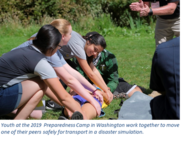
Youth: Apply Today for 2020 Preparedness Summer Camp in Alaska
FEMA Region 10 is seeking forty (40) high-school aged youth representing Alaska, Idaho, Oregon, and Washington to attend a Youth Preparedness Camp near Anchorage, Alaska in July 2020. This will be an engaging and empowering way for teens to learn about and practice emergency preparedness. There will also be a variety of exciting leadership opportunities, team building, and of course, traditional camp activities to ensure a fun week for all. The deadline to apply is 11:59pm PST on January 19, 2020. You can read about last year’s camp on FEMA’s Community News page and find additional information about the camp and how to apply here.
|
|
|
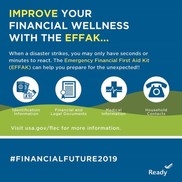
As the new year starts, many people are thinking about their New Year’s resolutions. Many people resolve to get in better physical shape, but what about getting in better financial shape? Getting in financial shape for emergencies is an easy goal for anyone to set this year! According to FEMA’s 2018 National Household Survey, almost seven out of ten people have set aside some money for an emergency, although most have set aside less than $500. In the new year, why not start saving or increase your emergency fund by an amount that makes sense for you? Read more…
|
|
|
|
Disclaimer: The reader recognizes that the federal government provides links and informational data on various disaster preparedness resources and events and does not endorse any non-federal events, entities, organizations, services, or products. Please let us know about other events and services for individual and community preparedness that could be included in future newsletters by contacting
FEMA-prepare@fema.dhs.gov.
|
|
|
|
|

|
| FEMA Stakeholder Advisory 1-10-2020: FEMA Urges Puerto Rico Residents to Listen to Local Officials |
| 01/10/2020 |
|
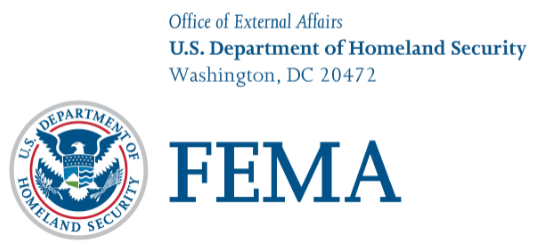
January 10, 2020
HQ-20-08
Contact: Congressional and Intergovernmental Affairs Division
Phone: 202-646-3444
Advisory
FEMA Urges Puerto Rico Residents to Listen to Local Officials
- FEMA continues to assist impacted municipalities in addressing emergency needs. FEMA personnel are embedded with local officials in Guánica, Guayanilla, Ponce, Peñuelas and Yauco to facilitate requests for assistance.
- FEMA and Puerto Rico officials, assisted by the Civil Air Patrol, continue conducting joint damage assessments in the most impacted municipalities of Guánica, Guayanilla, Lajas, Mayaguez, Orocovis, Peñuelas, Ponce, San Germán, San Sebastián, Utuado, Yauco.
- Disaster response is a whole community effort and most effective when it is locally executed, state managed and federally supported. Federal staff, equipment and commodities are on the ground supporting the government of Puerto Rico’s response and recovery efforts.
- Although aftershocks are natural, the USGS forecasts a decreased chance of aftershocks. However, if you live in the affected areas, follow instructions from local officials and monitor local radio, TV stations or official social media accounts for updated emergency information.
Local Officials are Leading the Response
- The Puerto Rico National Guard is assisting with operations including limited infrastructure assessment security/reconnaissance operations, evacuation support, and route clearance operations.
- An Army National Guard joint liaison team is en route to supplement resources.
- PREPA says it has restored power to approximately 50 percent of its customers and estimates they will be able to restore power to 90 percent of customers by Sunday, Jan. 12.
- Currently, 22 shelters are open, with more than 3,000 occupants. An additional 3,500 people are in non-traditional sheltering due to concerns about aftershocks.
- Follow instructions from your local officials. If you have a question about whether your home is safe to re-enter, consult your local government officials for guidance.
- Although many health care facilities are operating on generator power, there has been no impact on patient care or access. Two hospitals previously evacuated are now partially reoccupied. Of the affected health care facilities, 48 of 50 are open and operational; 23 on municipal power, 25 on generator power.
- Twenty water tank trucks are available to supply drinking water to critical facilities.
- There are 1,300 generators installed on the island, 800 of which are in use.
- For a list of shelters and other important information from local officials, visit http://www.manejodeemergencias.pr.gov/ or call the Puerto Rico Emergency Management and Disaster Administration Bureau at 787-724-0124 to find your nearest shelter.
Federal Agencies Supporting Local Efforts
- On Jan. 7, President Trump approved an emergency declaration allowing direct federal assistance for emergency measures to protect lives, property and public health after the recent series of earthquakes. This assistance is for all 78 municipalities in the Commonwealth of Puerto Rico.
- FEMA is maintaining a robust and flexible posture to support response efforts in Puerto Rico, with staff embedded in local municipal offices and with the Puerto Rico Emergency Management forward operations center.
- The whole community is involved with response efforts including private sector partners and non-governmental organizations like The Salvation Army and American Red Cross.
- Non-governmental organizations have set up feeding stations to assist survivors in the impacted areas.
- FEMA has taken the following actions to support Puerto Rico and local governments:
- FEMA delivered food, water and other commodities to survivors in impacted communities including Lajas, Guánica, Guayanilla, Ponce and Yauco.
- FEMA established Structural Assessment and Power Restoration Task Forces.
- Urban Search and Rescue and Incident Support Base personnel are actively engaged in operations.
- FEMA has prepositioned life-sustaining commodities, including meals and water throughout Puerto Rico.
- USGS staff are installing additional seismometers to monitor aftershocks.
- A U.S. Army Corps of Engineers Temporary Emergency Power Team is in Puerto Rico; equipment mobilization is expected to begin today.
- Representatives of the U.S. Department of Energy are in Puerto Rico consulting with private sector partners on ways to increase power generation after the loss of the Costa Sur power plant, which will be offline for a significant period of time.
- U.S. Department of Health and Human Services Secretary Alex Azar declared a public health emergency in Puerto Rico to ensure health care and services are available to meet the needs of recipients of Medicare, Medicaid and the Children’s Health Insurance Program.
- A liaison from the Health and Human Services Assistant Secretary for Preparedness and Response is in Puerto Rico to assist local officials.
- Staff from the Centers for Disease Control and Prevention are in Puerto Rico coordinating with local partners to assess conditions.
Potential for Response on Top of Ongoing Recovery
- When natural disasters such as Tuesday’s earthquake strike, the first responders are local emergency and public works personnel, volunteers, humanitarian organizations and numerous private sector groups. They provide emergency assistance required to protect the public’s health and safety and to meet immediate human need.
- FEMA continues to support the government of Puerto Rico with their complex and ongoing recovery efforts from Hurricanes Irma and Maria and to ensure everyone is better prepared for disasters that could impact the island, at all levels.
Earthquake Safety
- If you are experiencing stress or anxiety, you can call the Disaster Distress Helpline and speak to a crisis counselor. This confidential service is available free of charge, 24 hours a day in English and Spanish. To speak with a trained crisis counselor, call 1-800-985-5990 or text TalkWithUs to 66746 (for Spanish, press 2 or text Hablanos to 66746). The Puerto Rico Administration of Mental Health and Anti-Addiction Services Crisis Hotline is also available at 800-981-0023.
- If you are in the areas affected by the earthquake, please monitor local radio, TV stations or official social media accounts for updated emergency information.
- Aftershocks are a natural part of the process, although forecast to decrease, they may continue for some time. These secondary shockwaves are usually less violent than the main quake but can be strong enough to do additional damage to weakened structures and can occur in the first hours, days, weeks, or even months after the quake.
- During an earthquake, Drop, Cover and Hold On. Minimize your movements to a few steps to a nearby safe place.
- If you are indoors, stay there until the shaking has stopped and you are sure exiting is safe. Cover your head and neck with your arms or a pillow until the shaking stops.
- People with mobility disabilities who cannot drop, should still cover and hold on. People who use wheelchairs should lock their wheels and not try to transfer during shaking.
- Help injured or trapped persons if it is safe for you to do so. Check on neighbors who may require assistance such as infants, children, older adults, people with disabilities and others with access and functional needs.
- Check for gas leaks. If you smell gas or hear blowing or hissing noise immediately move away from the area. If you know how to turn the gas off, do so and report the leak to your local fire department and gas company.
- Additional earthquake safety and preparedness information is available at Ready.gov and Listo.gov.
If you have any questions, please contact the Office of External Affairs, Congressional and Intergovernmental Affairs Division at (202) 646-3444 or at FEMA-IGA@fema.dhs.gov.
####
FEMA’s mission is to help people before, during and after disasters.
Follow FEMA online, on Twitter @FEMA or @FEMAEspanol, on FEMA’s Facebook page or Espanol page and at FEMA’s YouTube account. Also, follow Acting Administrator Pete Gaynor’s activities @FEMA_Pete.

|
|
|